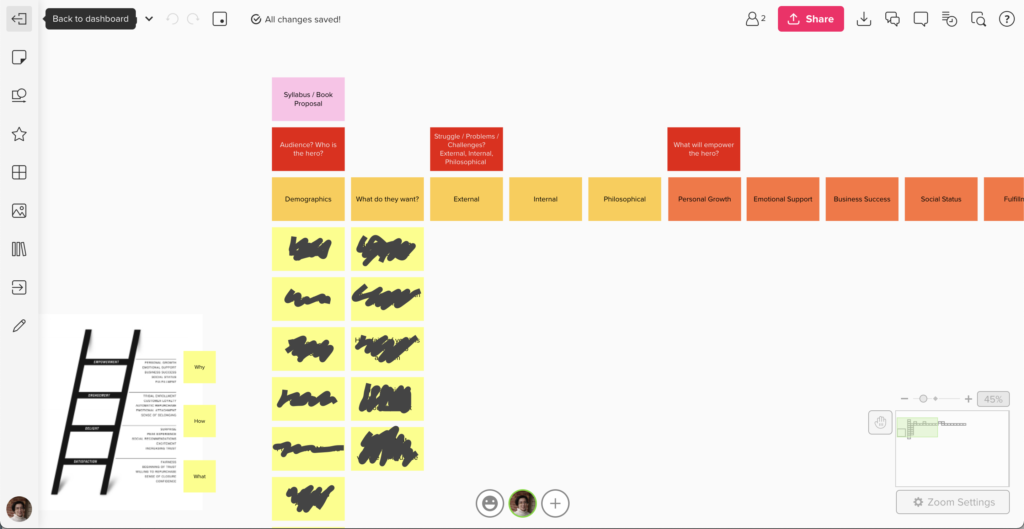In our last blog post, we shared an overview of the reasons for and components of an effective public platform syllabus. Today, we will take a closer look at the first step of developing a syllabus: identifying your target audience and describing their needs and desires.
Before Getting Started
Here are a couple of best practices to consider when getting started with your syllabus.
Two heads are better than one.
If you are creating a personal brand, it can be beneficial to start the process in the form of a conversation. For many it is easier to explain verbally who you want to reach, what those people may desire, what challenges they face, how you can act as a guide to them, and how you will make sure that those people find you. You could do this with anyone, but we recommend forming a team with others working on their own platforms, so that you can keep each other accountable, support each other, and ask the best questions.
Developing a syllabus forces you to think beyond your scholarly work and focus on the interests of your existing or imagined audience. It can uncover the blind spots in your current plan, or make you question whether having a platform is for you. For this challenging exercise, academics who use Public Platform have found it extremely helpful to have supportive and curious interlocutors who understand the methods and goals of public scholarship.
Lay out your ideas visually.
Arranging ideas visually is helpful both for generating and synthesizing ideas in the syllabus development process (or for any other kind of collaborative or creative work!).
At Public Platform, we have been using a digital collaboration tool called Mural to help our clients talk through their syllabi with us. Mural allows us to have virtual whiteboard brainstorming sessions, during which we deposit ideas onto sticky notes that can be arranged and rearranged as needed on our syllabus template.

Thinking About Your Audience
The purpose of Step 1 of your syllabus is to identify your target audience. In order to figure out who your target audience is, you should try to think of who would resonate with, benefit from, and form community around the content that you intend to share. Remember, your brand is going to be telling a story in which your audience members are the heroes and you are the guide.
It is very important that you have a focused target audience. This will make it easier for you to share content that tells a consistent story, as well as gather together a community of passionate and engaged audience members.
The description of your target audience should have two components: their demographics and their needs/desires.
Audience Demographics
The first component of the audience description is target audience demographics and psychographics. This can include a profession, interest, personal experience, belief system, ideological commitment, religious identity, political affiliation, location, educational background, age group, nationality, gender, racial or ethnic identity, etc. common to the people whom you would like to draw in, or who would take interest in your ideas. List out every characteristic you can think of that the majority of your audience might share.
If you find it difficult to narrow down the demographics of your target audience, it can be helpful to identify a primary and secondary set of audience demographics that might be interested in your work for different reasons.
For example, if you are a scholar with expertise in mitigating the negative effects of systemic factors on educational opportunity and achievement, you might feel that your work is relevant for everyone—policymakers, teachers, school administrators, education consultants, education students, parents, voters, etc. Pick one—perhaps educators, including teachers and administrators, in this case—as your primary audience, so that you can deliver reliably helpful content to those people. This focus doesn’t mean that others won’t tune in as well, or that you can’t ever create content that doesn’t fit perfectly the target audience’s needs. Your target audience might even shift over time. But in order to be an effective guide, you need to commit to a hero.
Try to be specific in your final description, particularly in terms of their interests and beliefs (e.g. instead of “Christian women,” “Evangelical Christian women who find the gender ideology of their conservative upbringing to be limiting, but have doubts about the morality of progressive ideas about gender.”
Audience Needs and Desires
The second component is the audience’s needs and desires—specifically, what they are seeking to learn, what questions they are hoping to find answers to, and what they want to accomplish. This may overlap with some of the demographic information above, but it is crucial to take this step separately and take the time to think about where your audience members want to get to, so that you can tailor your syllabus content to help them achieve their goals.
If we use the education example above, we could say the audience demographic is “K-12 educators who work in the public school system in the United States and are passionate about educational equity, but don’t feel equipped to support students whose families are affected by poverty, racism, xenophobia, etc.” The needs and desires might be “The audience desires to close gaps in achievement by providing equitable educational opportunities to students. They need resources to help them improve their pedagogies and advocate for their students.”
In our next blog post, we will look at Step 2 of the syllabus development process: describing our audience’s challenges.
Follow Public Platform on Facebook, Twitter, and LinkedIn to learn more about public scholarship.
